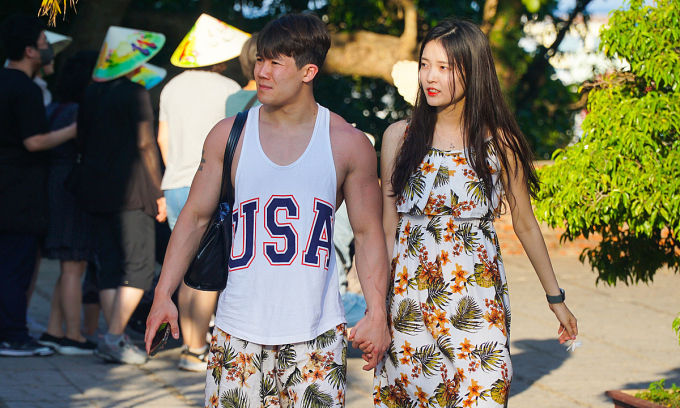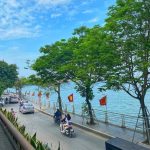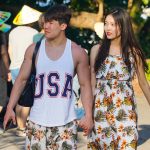Why are South Korean tourists flocking to Vietnam?
Low costs, cooler climate, friendly visa policy and rising popularity are among the main reasons for a recent surge in the number of South Koreans traveling Vietnam.

South Korean tourists visit Ponaga Tower in Nha Trang, central Vietnam, May 2023. Photo by VnExpress/Bui Toan
Oh Min Seok was surprised when he saw so many South Koreans at popular tourist destinations across Vietnam, including Nha Trang, Da Lat, Da Nang and Phu Quoc.
This year, he personally knew 6 compatriots from his home country that traveled to Vietnam as tourists. Seok said he plans to visit Con Dao, a 16-island archipelago off the southern coast in Ba Ria-Vung Tau, which neighbors Ho Chi Minh City, because of its pristine beauty. One of the main reasons that makes Seok love Vietnam is its cheap travel costs and hospitality. He arrived in Vietnam for the first time in 2018 and has returned to the country five times. “Traveling to Vietnam is a lot cheaper than other Southeast Asian countries such as Thailand and Malaysia,” Seok said. He said airfare from Busan to HCMC were around VND4 million while dining expenses for a five-day trip were a total VND4 million. “The expenses for a five-day holiday in Kuala Lumpur double compared to HCMC,” he added.
Due to his love for Vietnam, Seok has learned Vietnamese and can easily communicate with locals in order to delve deeper into Vietnamese culture. Seok is only one of millions of South Korean tourists to arrive in droves recently.
Since Vietnam reopened post-lockdown tourism in 2022, South Korea has surpassed China as the country’s biggest feeder tourism market. In the first six months of this year, South Korea continued to be the top source of tourists, with 2.28 million arrivals, followed by China (1.89 million). In addition to low costs, South Koreans also favor Vietnam due to its cooler climate than their homeland.
“I hate weather that is too hot or too cold. When I want to go to a warm country during the cold winter, I choose Vietnam or Thailand. Both countries have ideal weather but I think Vietnam is more comfortable so I often go to Vietnam at least once a year,” Kim Bomi said. Bomi said he had visited Da Nang, Nha Trang and Da Lat and these places offer beautiful natural landscapes and ideal weather. In Da Lat, a chilly resort town in the Central Highlands province of Lam Dong famous for its year-round cool climate, he was impressed by a large number of South Koreans holidaying there. He could hear the voices of his fellow countrymen throughout town. “Da Nang and Nha Trang have long been favorite destinations of South Koreans as you can order dishes in Korean. There are many restaurants serving Korean cuisine there,” Bomi said.
Increased direct flights from South Korea to Vietnam, friendly visa policies, and tourism campaigns on Korean media also helped drive tourism growth from the Northeast Asian country.
Park Han Su recounted that she fell in love with Vietnam through a Korean entertainment television program. She then determined to visit the Southeast Asian country when she realized Vietnam travel was both visa-free and cheap.
When mentioning Vietnam’s Da Lat, South Korean tourists often think about Lang Biang Mountain, Cu Lan Village and the town’s night market.
These tourist spots have appeared often on South Korean TV. Television stations in Korea, such as MBC, KBS, and SBS also show quite a lot of advertisements about Vietnamese tourism.
The media effect created by K-pop celebrities’ affinity for Vietnam has also helped spark a wave of interest among Koreans, tourism insiders said.
In KBS’s “Battle Trip” program, a trip to Da Nang by female artists Oh Hyun Kyung and Jung Si Ah was seen as helping to make Vietnam one of the top10 destinations most loved by Korean viewers.
South Korean carriers have been increasing direct routes to Vietnam’s top tourism destinations.
In May, T’way Air launched an additional daily Busan-Nha Trang flight. The total number of direct routes operated by T’way Air to Vietnam has increased to three with departures from Incheon, Cheongju, and Busan.
From June 19, the Daegu-Nha Trang route was also re-opened for the first time since Covid.
Eastar Jet, which already operates flights from Incheon to Nha Trang, also said it would launch a new route to Phu Quoc starting from July 19 with a frequency of seven round trips per week.
Since August last year, Vietnam has extended the stay duration for Korean tourists to 45 days from 15 days, and e-visas are valid for up to 90 days.
During a recent visit to South Korea, Prime Minister Pham Minh Chinh highlighted tourism cooperation between the two countries as “a bright spot of bilateral ties” and hoped both would work together to advance tourism ties to a new level.
By E.VNEXPRESS


















